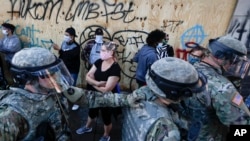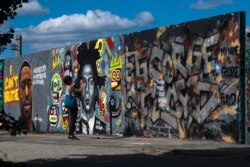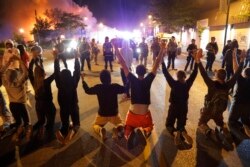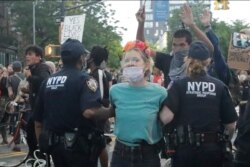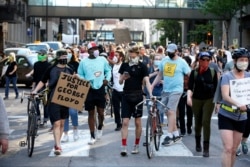The governor of Minnesota called Saturday for the full mobilization of the National Guard to confront what he called a “tightly controlled” group of outside protestors who have engaged in looting, arson and other acts of violence in Minneapolis and St. Paul.
The violence erupted in Minneapolis and its twin city of St. Paul for a fourth night Friday into Saturday morning in protest of the death of George Floyd, an African American man who died in the custody of a white police officer. The officer pressed his knee into Floyd’s neck as Floyd lay on the ground and pleaded repeatedly, “I can’t breathe.”
Video of the encounter has been seen around the world and has sparked outrage.
“This is not grieving, and this is not making a statement [about Floyd’s death] that we fully acknowledge needs to be fixed. This is dangerous, Walz said during a news conference. “You need to go home.”
Walz said he knew about unconfirmed news reports that mobs of white supremacists are exploiting the lawlessness in Minneapolis to trigger more chaos.
The governor suggested that organized agitators from outside the state were responsible for some of the violence, including white supremacists, anarchists and people associated with drug cartels.
“The sheer number of rioters has made it impossible to make coherent arrests,” Walz said. “The capacity to be able to do offensive action was greatly diminished” by the apparent range and organized nature of the violence.
Walz also said that “the terrifying thing is that this resembles more a military operation now as you observe ringleaders moving from place to place.”
Declaring that “our cities of Minneapolis and St. Paul are under assault,” Walz ordered the full mobilization of the National Guard, increasing its presence beyond the 700 soldiers who have already been deployed. Major General Jon Jensen of the Minnesota National Guard said there will be more than 1,700 National Guard in the area by Sunday.
The governor added he is collaborating with the federal government to gather information on who is participating in the violence and whether they are members of organized groups.
U.S. President Donald Trump urged Minneapolis Mayor Jacob Frey to get tough on violent protestors and said the military was ready to move in, reiterating this Saturday.
A peaceful protest in Portland, Oregon, about Floyd’s death, turned violent hours later when protesters broke into police headquarters and set a fire. The demonstrators also vandalized stores, set other fires and threw projectiles at police, according to an Associated Press report. Police described the turn of events as a “riot” on Twitter.
In Washington protests Friday at Lafayette Park outside the White House led officials to lock down the building. Reporters said protesters, some spray-painting a nearby building, clashed with Secret Service members. Protesters also removed part of a barricade.
Demonstrators in New York took to the streets for a second day Friday to protest Floyd’s death. Reports say some in the crowd pushed against metal barricades as police pushed back.
The Los Angeles Police Department declared an unlawful assembly after protesters smashed shop windows and blocked a freeway. Police marched into downtown Los Angeles to remove the demonstrators.
In Atlanta, Georgia, hundreds of protesters confronted police outside CNN headquarters, some throwing water bottles and chanting, “Quit your jobs.”
Protests also took place in Las Vegas and in Houston, where Floyd grew up. More than 60 protesters marched on the freeway in Houston for half an hour, shutting down traffic.
Minneapolis remains on edge following three nights of protests that started peacefully but gave way to arson and looting. Police used teargas in an effort to disperse the crowd.
Minneapolis Mayor Jacob Frey declared a nighttime curfew running from 8 p.m. Friday to 6 a.m. Saturday, which was widely ignored by protesters.
Minneapolis announced late Friday that a $500,00 bail has been set for Derek
Chauvin, the former police charged with Floyd’s death. He has been arrested and charged with murder and manslaughter.
Earlier Friday, officials in Hennepin County, Minnesota, announced the charges against Chauvin, who is seen in cellphone video of the incident kneeling on Floyd’s neck for about nine minutes as Floyd pleads that he cannot breathe.
Floyd was pronounced dead shortly after the video was taken. His family responded to the charges, saying in a statement it wants prosecutors to take a tougher approach.
“The arrest of former Minneapolis police officer Derek Chauvin for the brutal killing of George Floyd is a welcome but overdue step on the road to justice. We expected a first-degree murder charge. We want a first-degree murder charge. And we want to see the other officers arrested. We call on authorities to revise the charges to reflect the true culpability of this officer.”
Derrick Johnson, president and CEO of the civil rights group NAACP, told VOA that the killing of Floyd shows that “we have in this country not dealt with the issues of race and the value of African American lives in Minneapolis.”
He said peaceful protests are “a way for the citizens of this country to bring forth grievances of injustice,” and said the NAACP “absolutely oppose rioting, that never solves anything.”
“This is not a protest,” Atlanta Mayor Keisha Lance Bottoms said in an emotional plea to the demonstrators in the Southern city. “This is chaos. A protest has purpose. . . You are disgracing our city. We are better than this as a city. We are better than this as a country.” Five hundred Georgia National Guard are being deployed to Atlanta.
U.S. President Donald Trump said Friday that he had spoken with the family of Floyd and expressed his sorrow. Speaking during an event at the White House, Trump said "we can't allow" the demonstrations in Minneapolis "to descend further into lawless anarchy and chaos." He said looters should not be able to drown out peaceful protests.
Protesters vented their anger in Minneapolis Thursday night, setting a police precinct and businesses on fire and smashing windows of businesses. The National Guard was mobilized as St. Paul was also rocked by another night of violence.
The death of Floyd was captured on cellphone video that went viral after it was posted online. “Please, please, please, I can’t breathe. Please, man,” Floyd pleaded, while being restrained by officer Chauvin.
Chauvin told a handcuffed Floyd to “relax,” but the officer kept his knee on Floyd’s neck after the unarmed man stopped moving. One witness said he heard Floyd calling out for his mother. The video shows Floyd's head turned to the side and he does not appear to be resisting. Toward the end of the video, paramedics arrive, lift a limp Floyd onto a stretcher and place him in an ambulance. Authorities later told reporters Floyd died at the hospital.
Minneapolis police said Floyd resembled a suspect wanted for allegedly trying to spend a counterfeit $20 bill in a food store and that he had resisted arrest.
U.S. Attorney General William Barr said Friday the images “of the incident that ended with the death of Mr. Floyd, while in custody of Minneapolis police officers, were harrowing to watch and deeply disturbing.” Barr also said an independent investigation is being conducted by the Justice Department and the FBI.
Former President Barack Obama tweeted Friday about Floyd’s death, calling on the country to treat all citizens with dignity and respect.
“It’s natural to wish for life ‘to just get back to normal’ as a pandemic and economic crisis upend everything around us. But we have to remember that for millions of Americans, being treated differently on account of race is tragically, painfully, maddeningly ‘normal.’
“It shouldn’t be ‘normal’ in 2020 America,” Obama added. “It can’t be ‘normal.”




